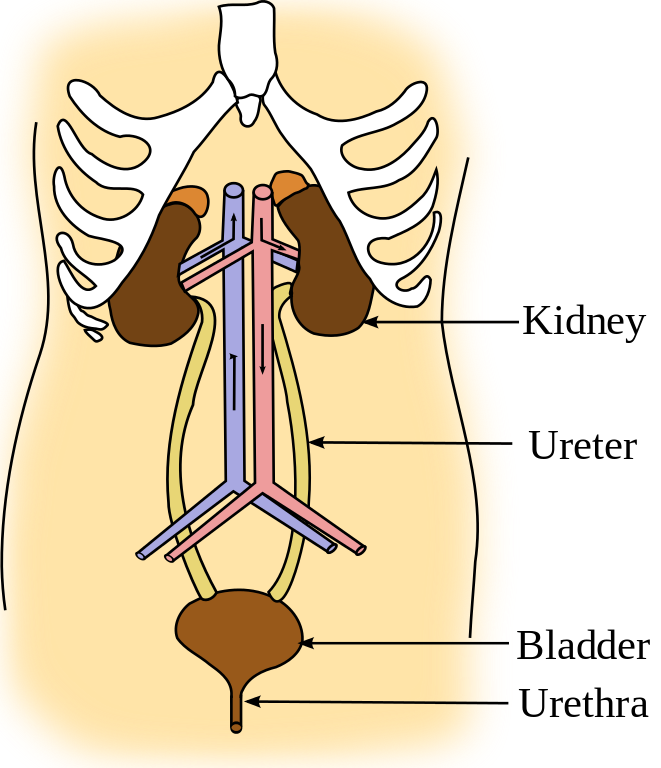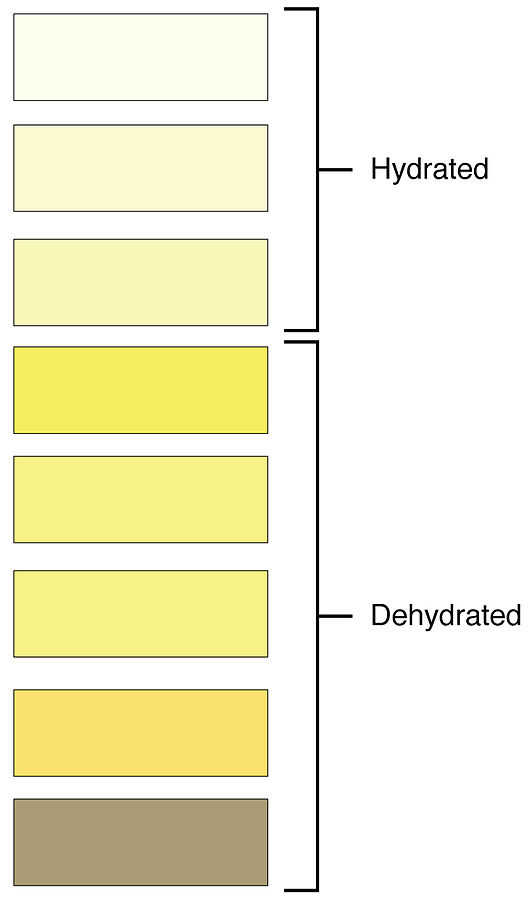11.7 Urinary System
The urinary system includes the kidneys, ureters, bladder, and urethra. It has many functions including filtering the blood and eliminating wastes, regulating blood and urine pH levels, and working in collaboration with the cardiovascular system to regulate blood pressure. The urinary system also provides reproductive functions in the prostate for males. The kidneys also release a hormone that stimulates red blood cell production and synthesizes vitamin D to assist in bone health. Each of these functions is vital to well-being and survival.[1] See Figure 11.10[2] for an illustration of the structures of the urinary system.

Blood is filtered through the kidneys, and the filtrate is transformed into urine at a relatively constant rate throughout the day. The urine travels from the kidneys through the ureters to the bladder. The bladder stores urine and signals the brain when full (around 300 mL). It stores urine until a convenient time for elimination or voiding, and then the brain allows the urethra to release the urine.[3]
Urine is a fluid of variable composition. Urine characteristics change depending on influences such as water intake, exercise, environmental temperature, nutrient intake, and other factors. Characteristics such as color and odor provide a rough estimate of a person’s state of hydration. For example, after exercising or working outside on a hot day and sweating heavily, urine will become darker with a slight odor.[4] See Figure 11.11[5] for ranges of urinary color related to hydration status. Review the subsection “Observation and Documentation of Urinary Output” in Chapter 5.8 for other characteristics that nursing assistants should document when assisting clients to void.

Urine volume varies considerably. The normal range of urine output for an adult is one to two liters per day. The kidneys must produce a minimum urine volume of about 500 mL/day to adequately eliminate wastes from the body. Output below this level can be caused by severe dehydration or kidney disease.[6]
The effects of failure of various parts of the urinary system can range from incontinence to kidney disease with a life-threatening loss of the ability to eliminate wastes. When the kidneys begin to fail, several symptoms may occur such as weakness, shortness of breath, widespread edema (swelling), rising potassium levels, and heart arrhythmias.[7]
Failure of voluntary control of urination is called incontinence. Incontinence may occur if the connection between the brain and the urethra is disrupted or there is loss of muscle tone in the urinary system. There are several types of incontinence. Incontinence in small amounts (i.e., leaking or dribbling) can occur from coughing, laughing, or moving when the bladder is full. Some people feel an urge to void and then must go immediately or incontinence may occur if they are not near a restroom. Some people have total loss of control of urination, resulting in the entire contents of their bladder being released involuntarily.[8] Refer to section Chapter 5.8, “Assisting With Toileting” to review appropriate interventions to help prevent incontinence.
The prostate gland encompasses the urethra in males. As males age, the prostate gland grows, known as benign prostate enlargement (BPE). Because prostate enlargement puts pressure on the urethra, the urine may become blocked. Older men may experience difficulty starting the stream of urine or become unable to completely empty their bladder. If the blockage becomes significant, it can cause infection when urine remains in the bladder for long periods of time. In these cases, a urinary catheter may be placed to reduce the retention of urine, or a surgical procedure may be completed to reopen the urethra.
See Table 11.7 for common chronic conditions, symptoms to report, and interventions nursing assistants can provide to promote urinary health.
Table 11.7 Common Chronic Conditions of the Urinary System and Related Interventions[9],[10],[11],[12]
| Diagnosis | Definition | Symptoms to Report | Nursing Assistant Interventions |
|---|---|---|---|
| Urinary Incontinence | Inability to control the elimination of urine. | Change in the frequency or amount of incontinence. |
|
| Urinary Tract Infection (UTI) | Infection of any part of the urinary system. | Increased frequency of voiding; pain, itching, or burning with voiding; voiding in small amounts; strong odor; dark or cloudy urine; and/or sediment or blood in the urine. A sudden increase in confusion can also indicate infection. |
|
| Kidney Stones | Deposits of minerals from concentrated urine that form a mass in the kidneys. | Increased pain in the abdomen or pain with voiding. |
|
| Chronic Kidney Failure | Kidneys are unable to adequately filter and remove wastes and fluids from the body. | Puffiness around the eyes, frequent urge to urinate, urination in increasingly smaller amounts, dry and itchy skin, and/or fatigue. |
|
- This work is a derivative of Human Nutrition by University of Hawai‘i at Mānoa Food Science and Human Nutrition Program and is licensed under CC BY NC SA 4.0 ↵
- “llu_urinary_system.svg” by Thstehle is in the Public Domain ↵
- This work is a derivative of Human Nutrition by University of Hawai‘i at Mānoa Food Science and Human Nutrition Program and is licensed under CC BY NC SA 4.0 ↵
- This work is a derivative of Human Nutrition by University of Hawai‘i at Mānoa Food Science and Human Nutrition Program and is licensed under CC BY NC SA 4.0 ↵
- “2601_Urine_Color_Chart.jpg” by OpenStax College is licensed under CC BY 3.0 ↵
- This work is a derivative of Human Nutrition by University of Hawai‘i at Mānoa Food Science and Human Nutrition Program and is licensed under CC BY NC SA 4.0 ↵
- This work is a derivative of Human Nutrition by University of Hawai‘i at Mānoa Food Science and Human Nutrition Program and is licensed under CC BY NC SA 4.0 ↵
- This work is a derivative of Human Nutrition by University of Hawai‘i at Mānoa Food Science and Human Nutrition Program and is licensed under CC BY NC SA 4.0 ↵
- Mayo Clinic Staff. (2021, December 17). Urinary incontinence. https://www.mayoclinic.org/diseases-conditions/urinary-incontinence/symptoms-causes/syc-20352808 ↵
- Mayo Clinic Staff. (2021, April 23). Urinary tract infection (UTI). https://www.mayoclinic.org/diseases-conditions/urinary-tract-infection/symptoms-causes/syc-20353447 ↵
- Mayo Clinic Staff. (2022, June 3). Kidney stones. https://www.mayoclinic.org/diseases-conditions/kidney-stones/symptoms-causes/syc-20355755 ↵
- Mayo Clinic Staff. (2021, September 3). Chronic kidney disease. https://www.mayoclinic.org/diseases-conditions/chronic-kidney-disease/symptoms-causes/syc-20354521 ↵
A lack of voluntary control over urination or defecation.

